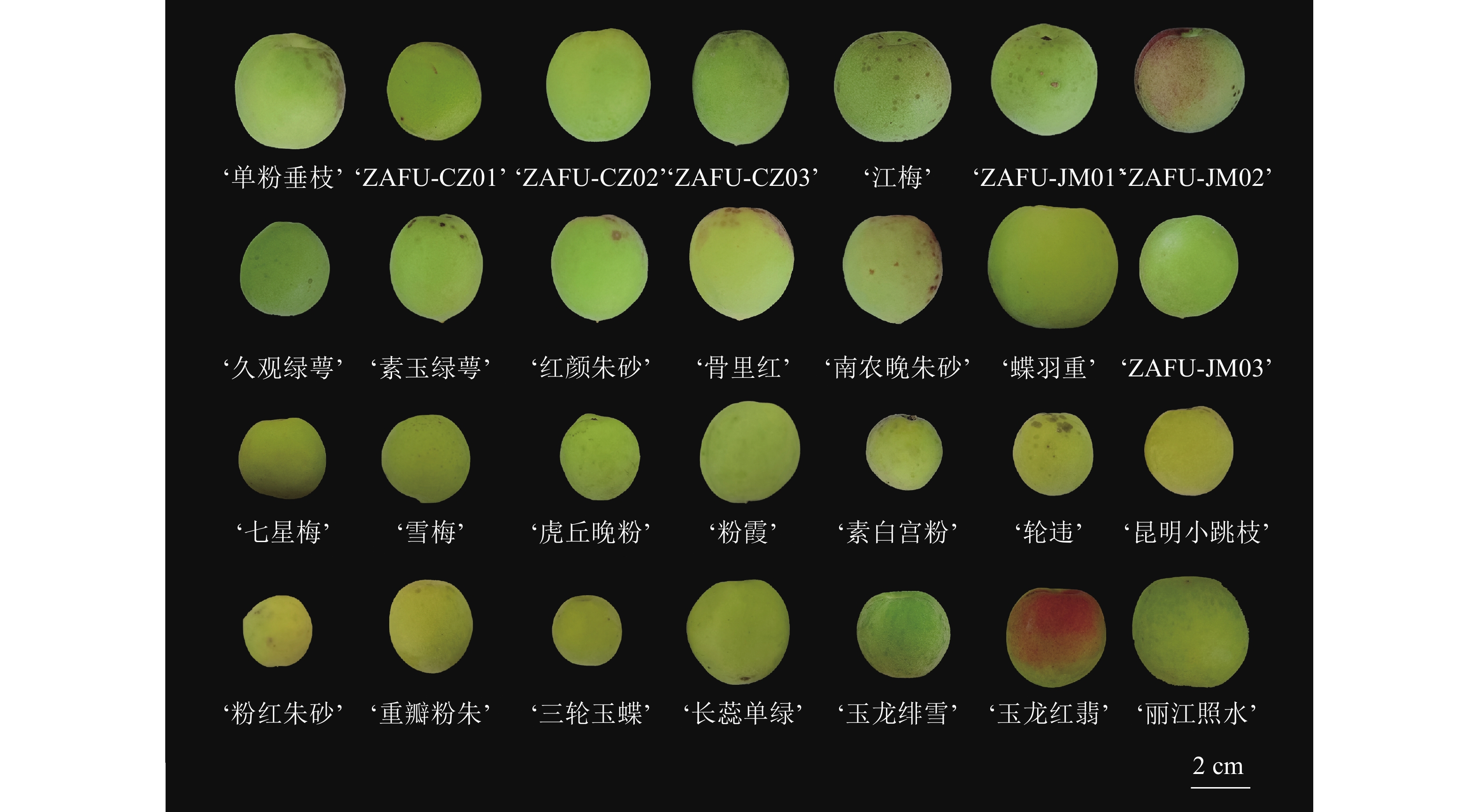-
梅Prunus mume为蔷薇科Rosaceae李属Prunus小乔木,花期1—3月,果期5—6月,是中国重要的传统名花与嘉果,已有3000多年的栽培历史[1−2]。梅分布于中国、韩国、日本等国家,在中国17个省有栽培[3]。根据栽培目的不同,梅分为花梅与果梅,花梅观赏价值高,果梅可进行果实加工利用,花果兼用梅兼顾梅花观赏与果实加工,是梅育种的五大目标之一,相比单一用途而言,应用周期延长,经济效益大增,具有良好的应用前景[4−5]。梅花花朵观赏价值高,花瓣、花色种类丰富,品种繁多,是中国重要的早春观赏花木。截至2017年,梅国际登录品种为486种[6]。梅果实可药食两用,不仅营养价值高,富含有机酸、糖类、矿质元素、维生素等营养成分,还含有酚类等生物活性物质及较高的抗氧化活性,其果实提取物具有抑菌、抗骨质疏松、抗癌等功效[7−10];梅果实具有高酸低糖的特点,被誉为强碱性健康食品,不宜生食,常被加工为果脯、青梅酒、果汁与果酱等形式消费[11−14]。中国梅育种专家运用实生选种、芽变选种、杂交育种等方法,在青岛、武汉、南京、丽江等地展开了花果兼用梅品种选育,筛选出几十种花果兼用梅品种,近年来又选育出‘玉龙红翡’‘南农丰羽’等花果兼用品种。目前筛选出的一些品种结实能力不强,未达到食用或加工的标准,高产量、花重瓣、花色艳丽、果实可供加工利用的花果兼用梅品种较少,亟待选育[15−17]。浙江、云南、江苏是中国重要的梅种质资源分布地区。云南是梅的原产地,‘丽江照水’‘玉龙红翡’‘玉龙绯雪’分布于此。浙江梅种质资源圃收集了60种花梅品种,江苏梅种质资源圃收集了50种花梅品种。在前期调查的基础上,本研究选取了28个结实的梅品种作为研究对象进行分析及评价,旨在为花果兼用梅的品种选育及梅果实加工提供理论依据。
-
2021—2022年,选取浙江杭州、云南丽江、江苏新沂等3个梅种质资源圃中28个结实的梅品种作为试验材料(表1),于盛花期采集花朵测定花部表型性状,于果实退绿期测定果实品质。随机采集每个品种树冠东西南北4个方向30个成熟度、大小均匀一致的果实,采后24 h内运回实验室。一部分果实用于果实外观品质的测定,另一部分切成小块,液氮速冻放入−80 ℃冰箱中保存,用于果实内在品质的测定。
采收地点 经纬度 品种名 浙江杭州 30°15′N,119°43′E ‘单粉垂枝’‘ZAFU-CZ01’‘ZAFU-CZ02’‘ZAFU-CZ03’‘江梅’‘ZAFU-JM01’‘ZAFU-JM02’‘ZAFU-JM03’‘久观绿萼’‘素玉绿萼’‘红颜朱砂’‘骨里红’‘南农晚朱砂’‘蝶羽重’ 云南丽江 26°44′N,100°15′E ‘丽江照水’‘玉龙红翡’‘玉龙绯雪’ 江苏新沂 34°20′N,118°32′E ‘七星梅’‘雪梅’‘虎丘晚粉’‘粉霞’‘素白宫粉’‘轮违’‘昆明小跳枝’‘粉红朱砂’‘重瓣粉朱’‘三轮玉蝶’‘长蕊单绿’ Table 1. Name and harvest place of P. mume cultivars
-
记录各品种的花径、花瓣数量、花色参数,参考李冉馨等[18]的标准进行分级:花径(d)>36 mm为极大、28<d≤36 mm为大、23<d≤28 mm为中、17<d≤23 mm为小、d≤17 mm为极小;花瓣数量(N)≥45枚为极重瓣品种,26≤N≤44枚为重瓣品种,15≤N≤25枚为半重瓣品种,9≤N≤14枚为复瓣品种,5≤N≤8枚为单瓣品种;花色采用CR-10型便携式色差仪测定,记录各品种花色参数L*、a*、b*。以上指标每个品种5次生物学重复。
-
参考史寒昀等[19]的文献(略加改动),将结实量划分为易结实、较易结实、少量结实、偶结实等4类。
-
采用电子数显游标卡尺测定果实横径、纵径、侧径,并计算果形指数,果形指数=纵径/横径[20]。单果质量、核质量采用千分之一电子天平测定,测定完成后计算果实可食率,可食率=(单果质量−核质量)/单果质量×100%[18]。以上指标5次生物学重复。
-
果实的可溶性固形物质量分数(%)采用手持折光仪(LH-T20)测定;果实总酸质量分数(%)采用酸碱滴定法测定[18];可溶性总糖质量分数(%)采用蒽酮比色法测定[21];可溶性蛋白质量分数(mg·g−1)采用考马斯亮蓝G-250染色法测定[22]。以上指标均为3次生物学重复。
-
数据均用Excel 2016进行统计整理,用平均值±标准差表示,并运用SPSS 21.0进行主成分分析,利用Origin 2021进行相关性分析、聚类分析绘图。
-
不同梅品种的花部性状存在差异(表2及图1)。28个梅品种的花径为19.14~31.38 mm,其中53.57%的梅品种花径分布在23.00~28.00 mm,42.86%的梅品种花径分布在17.00~23.00 mm,28.00~35.00 mm的大花品种占比仅为3.57%。花径较大的品种为‘蝶羽重’‘单粉垂枝’‘江梅’‘骨里红’。28个梅品种花瓣数量分布范围为5~23枚,单瓣品种与半重瓣品种占比各为50.00%。28个梅品种中白色品种占比最大,为50.00%,其次为粉色、紫红色品种,占比分别为28.57%与10.71%。花色参数L*分布范围为32.9~89.3,白色品种如‘江梅’‘久观绿萼’及跳枝品种‘昆明小跳枝’明度较高,而‘红颜朱砂’‘骨里红’‘南农晚朱砂’等紫红色品种明度较低;a*分布范围为−1.9~41.4,a*较高的品种为‘红颜朱砂’‘骨里红’‘南农晚朱砂’,白色品种a*较低,有的为负值,如‘江梅’‘久观绿萼’‘七星梅’‘素玉绿萼’等;b*分布范围为−1.4~18.3,多数品种b*为正值,b*最高的品种为‘素玉绿萼’,最低的品种为‘骨里红’。
品种名 花径/mm 花瓣数量/枚 L* a* b* 花色 ‘ZAFU-CZ01’ 25.19±1.29 16±2 87.8±0.5 0.4±0.1 12.1±1.5 白色 ‘ZAFU-CZ02’ 25.14±1.86 5±0 78.3±1.6 11.9±2.3 1.7±1.2 浅粉色 ‘ZAFU-CZ03’ 22.60±1.94 5±0 82.2±0.9 1.6±0.3 8.1±2.3 白色 ‘ZAFU-JM01’ 22.78±1.88 5±1 86.3±0.5 −0.8±0.3 9.9±2.4 白色 ‘ZAFU-JM02’ 19.36±2.25 5±0 86.6±1.6 −1.9±0.5 13.4±1.7 白色 ‘ZAFU-JM03’ 19.14±0.71 5±0 86.5±0.8 −0.6±0.2 10.7±1.7 白色 ‘单粉垂枝’ 27.59±0.41 5±0 80.0±1.5 6.8±1.2 8.5±0.6 浅粉色 ‘蝶羽重’ 31.38±0.86 17±1 84.0±0.9 5.0±1.3 4.9±1.3 浅粉色 ‘粉红朱砂’ 24.57±2.05 17±1 51.2±3.2 41.4±2.4 1.1±0.8 紫红色 ‘粉霞’ 19.80±0.60 18±2 71.9±1.7 19.7±1.8 3.0±0.8 粉色 ‘骨里红’ 25.46±1.48 17±2 50.5±3.3 34.0±4.8 −1.4±1.0 紫红色 ‘红颜朱砂’ 24.21±1.59 18±2 47.0±1.3 42.4±0.7 1.2±0.2 紫红色 ‘虎丘晚粉’ 23.43±1.38 21±3 61.6±7.6 30.9±6.5 0.9±0.3 粉色 ‘江梅’ 26.95±2.17 5±0 87.2±1.3 −1.8±0.1 12.2±2.7 白色 ‘久观绿萼’ 27.08±1.39 17±2 88.9±2.3 −1.7±0.3 14.7±2.9 白色 ‘昆明小跳枝’ 22.45±2.10 16±1 85.4±1.7 3.7±1.4 6.7±1.4 复色 ‘丽江照水’ 23.72±2.07 5±0 77.2±2.5 10.8±3.3 5.1±2.2 粉色 ‘轮违’ 21.73±2.89 17±1 84.2±0.9 4.5±2.7 7.9±1.3 复色 ‘南农晚朱砂’ 21.90±0.91 5±1 32.9±2.0 34.6±2.0 1.4±0.8 紫红色 ‘七星梅’ 25.59±1.78 6±1 86.3±1.3 −0.3±0.7 11.2±1.7 白色 ‘三轮玉蝶’ 23.86±0.77 15±0 87.8±0.9 0.1±1.0 10.1±0.7 白色 ‘素白宫粉’ 21.99±1.23 16±2 80.8±1.9 8.7±2.0 5.4±1.7 粉色 ‘素玉绿萼’ 21.61±1.29 15±1 89.3±1.7 −1.5±0.3 18.3±2.4 白色 ‘雪梅’ 23.25±0.69 5±0 83.7±1.6 2.5±2.4 8.3±1.5 白色 ‘玉龙绯雪’ 24.72±3.87 5±0 77.8±1.6 8±0.6 4.5±3.2 白色 ‘玉龙红翡’ 21.95±1.38 5±0 83.9±1.4 1.6±1.1 8.7±2.5 白色 ‘长蕊单绿’ 22.00±1.18 5±0 86.6±1.0 −1.3±0.2 9.2±2.6 白色 ‘重瓣粉朱’ 23.52±1.15 23±1 63.3±3.4 30.6±3.0 1.5±1.5 粉色 说明:数值为平均值±标准差。 Table 2. Flower traits of 28 P. mume cultivars
-
对梅品种结实量进行调查发现:28个梅品种均有一定的结实量,且不同梅品种结实量存在差异(表3)。易结实与较易结实的品种有‘丽江照水’‘玉龙红翡’‘玉龙绯雪’等11个品种,其余品种结果量较少,‘粉红朱砂’‘久观绿萼’属于偶结实品种。
结实情况 描述 品种 易结实 2 a均结实,结实量为5~10 kg·株−1或
10 kg·株−1以上‘丽江照水’‘玉龙红翡’‘玉龙绯雪’ 较易结实 2 a均结实,结实量为1~5 kg·株−1 ‘单粉垂枝’‘江梅’‘红颜朱砂’‘骨里红’‘ZAFU-JM01’‘素玉绿萼’‘南农晚朱砂’‘ZAFU-CZ01’ 少量结实 2 a均结实,结实量小于1 kg·株−1 ‘雪梅’‘ZAFU-JM02’‘ZAFU-JM03’‘重瓣粉朱’‘粉霞’‘虎丘晚粉’‘昆明小跳枝’‘轮违’‘七星梅’‘三轮玉蝶’‘素白宫粉’‘长蕊单绿’‘ZAFU-CZ02’‘ZAFU-CZ03’‘蝶羽重’ 偶结实 仅观测到1 a结实,结实量小于1 kg·株−1 ‘久观绿萼’‘粉红朱砂’ Table 3. Investigation on fruit load of 28 P. mume cultivars
-
对28个梅品种果实外观品质进行测定,结果表明:不同品种间果实横径、纵径、侧径、果形指数、单果质量、可食率存在差异(图2~3和表4)。由图3和表4可知:28个品种果实横径为22.41~36.88 mm,纵径为22.59~36.83 mm,侧径为21.25~34.49 mm,变异系数较小,分别为11.42%、11.56%、10.58%。单果质量为6.56~27.91 g,变异系数为30.68%。横径、纵径、侧径、单果质量、核质量最大的品种均为‘蝶羽重’,最小的品种为‘三轮玉蝶’。果形指数为纵径与横径之比,其变化范围为0.92~1.20,集中分布于0.95~1.05。‘江梅’果形指数最小,‘ZAFU-CZ03’果形指数最大,说明江梅果实为扁圆形,而‘ZAFU-CZ03’为长圆形。28个品种的可食率变异系数最小,多数品种分布在86.00%~90.00%,以‘江梅’最高,可食率为92.91%,最低的品种为‘三轮玉蝶’,可食率为82.93%。
品质指标 横径/
mm纵径/
mm侧径/
mm果形指数 单果质
量/g核质量/
g可食率/
%可溶性固形物
质量分数/%总酸质量
分数/%可溶性总糖
质量分数/%可溶性蛋白质量
分数/(mg·g−1)极小值 22.41 22.59 21.25 0.92 6.56 1.00 82.93 6.20 4.51 0.42 2.78 极大值 36.88 36.83 34.49 1.20 27.91 2.91 92.91 14.30 7.00 3.30 9.95 均值 29.46 30.07 27.61 1.02 14.91 1.75 87.82 9.14 5.81 1.46 5.68 标准差 3.36 3.47 2.92 0.06 4.57 0.47 2.28 2.11 0.71 0.78 2.05 变异系数/% 11.42 11.56 10.58 5.83 30.68 26.66 2.60 23.07 12.24 53.22 36.02 Table 4. Variation of P. mume fruit quality indexes
-
28个梅品种果实可溶性固形物、总酸、可溶性总糖、可溶性蛋白质量分数存在差异(表4、图4)。果实可溶性固形物质量分数是果实糖、酸等溶于水的物质的质量分数的总和[23],28个品种的可溶性固形物质量分数为6.20%~14.30%,变异系数为23.07%,多数品种集中为7.0%~8.0%,其中质量分分数最高的品种为‘粉红朱砂’,最低的品种为‘ZAFU-JM03’。总酸质量分数为4.51%~7.00%,‘粉红朱砂’最高,‘蝶羽重’最低,多数品种集中为5.0%~6.0%。可溶性总糖质量分数变异系数最大,多数品种为0.5%~1.5%,其中‘昆明小跳枝’最高,‘ZAFU-CZ03’最低。可溶性蛋白质量分数变异系数为36.02%,多数品种为3.0~6.0 mg·g−1,质量分数最低的为‘蝶羽重’,最高的为‘素白宫粉’。
-
由图5可知:梅花部性状与果实品质指标存在相关性。花径与侧径、单果质量呈显著正相关(P<0.05);花瓣数量与a*、可溶性固形物质量分数呈极显著正相关(P<0.01);L*与a*呈极显著负相关,与b*呈极显著正相关,与可食率呈显著正相关(P<0.05);果实横径、纵径、侧径与单果质量、核质量、可食率呈极显著正相关,与可溶性固形物、总酸、可溶性蛋白质量分数呈极显著负相关(P<0.01);果形指数与可食率呈极显著负相关(P<0.01);可食率与可溶性固形物质量分数呈显著负相关(P<0.05);可溶性固形物质量分数与总酸、可溶性蛋白质量分数呈极显著正相关(P<0.01),与可溶性总糖质量分数呈显著正相关(P<0.05);总酸质量分数与可溶性蛋白质量分数呈极显著正相关(P<0.01)。以上结果表明16个指标信息具有重叠性,适宜运用主成分分析评价。
-
由表5可知:对28个品种的16个花部性状与果实品质指标进行主成分分析,提取了4个特征根大于1的公因子,累计方差解释百分比为80.772%,反映了绝大部分原始信息。主成分1方差贡献率为41.43%,代表横径、纵径、侧径、单果质量、核质量以及可溶性固形物、总酸、可溶性总糖和可溶性蛋白质量分数,主成分2的方差贡献率为21.37%,代表L*、a*、b*;主成分3方差贡献率为11.18%,代表花径、果形指数;主成分4方差贡献率为6.80%,代表花瓣数量。
组分 F1 F2 F3 F4 载荷值 特征向量 载荷值 特征向量 载荷值 特征向量 载荷值 特征向量 花径(x1) 0.338 0.131 0.110 0.059 0.564 0.421 0.438 0.420 花瓣数量(x2) −0.402 −0.156 0.441 0.239 0.223 0.167 0.602 0.577 L*(x3) 0.150 0.058 −0.873 −0.472 −0.066 −0.050 0.268 0.257 a*(x4) −0.245 −0.095 0.887 0.480 0.188 0.140 −0.154 −0.147 b*(x5) 0.168 0.065 −0.847 −0.458 −0.281 −0.210 0.258 0.248 横径(x6) 0.947 0.368 0.025 0.014 0.246 0.184 −0.126 −0.121 纵径(x7) 0.899 0.349 0.295 0.160 −0.093 −0.070 0.050 0.048 侧径(x8) 0.919 0.357 −0.020 −0.011 0.332 0.248 −0.031 −0.029 果形指数(x9) −0.049 −0.019 0.524 0.284 −0.625 −0.468 0.341 0.327 单果质量(x10) 0.930 0.361 0.133 0.072 0.254 0.190 −0.038 −0.037 核质量(x11) 0.698 0.271 0.524 0.284 −0.092 −0.069 −0.057 −0.055 可食率(x12) 0.593 0.230 −0.474 −0.256 0.439 0.328 −0.025 −0.024 可溶性固形物(x13) −0.839 −0.326 0.018 0.010 0.376 0.281 −0.025 −0.024 总酸(x14) −0.662 −0.257 −0.078 −0.042 0.270 0.202 −0.121 −0.116 可溶性总糖(x15) −0.682 −0.265 0.014 0.007 0.479 0.358 0.240 0.230 可溶性蛋白(x16) −0.616 −0.239 −0.243 −0.131 0.152 0.114 −0.396 −0.380 特征根 6.629 3.419 1.789 1.087 方差贡献率/% 41.429 21.366 11.183 6.794 累计方差贡献率/% 41.429 62.795 73.978 80.772 Table 5. Principal component loading values, characteristic values and contribution rates of P. mume quality indexes
根据表5可得综合评价模型为F=41.429%F1+21.366%F2+11.183%F3+6.794%F4,并计算各品种的主成分得分。主成分综合得分及排名情况如表6中所示,综合得分越高,表明此品种综合品质越好。由表6可知:‘蝶羽重’‘骨里红’‘单粉垂枝’‘红颜朱砂’‘ZAFU-CZ02’‘江梅’‘丽江照水’得分较高,较为优良,而‘三轮玉蝶’‘粉红朱砂’‘素白宫粉’‘轮违’‘虎丘晚粉’等品种得分较低,综合品质较差。
品种 F1 F2 F3 F4 综合得分 排名 ‘蝶羽重’ 5.624 1.397 2.208 1.976 3.010 1 ‘骨里红’ 1.669 3.235 1.163 −0.176 1.501 2 ‘单粉垂枝’ 3.204 −1.030 1.606 −0.578 1.247 3 ‘红颜朱砂’ 1.007 3.351 0.110 0.069 1.150 4 ‘ZAFU-CZ02’ 2.036 1.657 −0.913 −0.054 1.092 5 ‘江梅’ 3.000 −2.296 1.970 0.426 1.001 6 ‘丽江照水’ 1.825 −0.102 1.674 −2.499 0.752 7 ‘南农晚朱砂’ 0.508 3.756 −1.845 −1.621 0.696 8 ‘ZAFU-CZ03’ 1.651 0.937 −3.450 0.621 0.541 9 ‘粉霞’ 0.274 1.530 −0.528 −0.229 0.366 10 ‘重瓣粉朱’ −1.215 2.554 0.506 0.999 0.167 11 ‘长蕊单绿’ 1.245 −1.024 −0.566 −1.096 0.159 12 ‘素玉绿萼’ 1.223 −1.069 −2.362 1.404 0.110 13 ‘ZAFU-JM01’ 0.574 −0.819 0.100 0.394 0.101 14 ‘ZAFU-JM03’ 1.800 −2.007 −1.270 −1.191 0.094 15 ‘玉龙红翡’ 0.945 −1.344 −0.391 −0.794 0.007 16 ‘久观绿萼’ 0.386 −1.2·46 −0.507 2.065 −0.023 17 ‘ZAFU-CZ01’ 0.135 −1.292 −0.073 1.346 −0.137 18 ‘ZAFU-JM02’ 0.736 −2.147 −0.919 −0.949 −0.321 19 ‘玉龙绯雪’ −0.805 −0.495 −0.353 −0.845 −0.536 20 ‘七星梅’ −0.448 −2.238 0.968 −0.228 −0.571 21 ‘雪梅’ −1.381 −1.523 −0.059 −0.366 −0.929 22 ‘虎丘晚粉’ −3.626 2.204 0.312 0.642 −0.953 23 ‘昆明小跳枝’ −3.100 −0.915 1.381 0.495 −1.292 24 ‘轮违’ −3.204 −1.002 0.258 0.428 −1.484 25 ‘素白宫粉’ −3.590 −0.304 0.401 −0.210 −1.522 26 ‘粉红朱砂’ −5.768 1.667 1.683 −0.485 −1.878 27 ‘三轮玉蝶’ −4.704 −1.431 −1.105 0.456 −2.347 28 Table 6. Scores and rankings of principal components of 28 P. mume cultivars
-
对28种梅品种的果实品质指标进行系统聚类分析(图6),当欧氏距离为24时,28个品种可分为6类。第1类包括‘单粉垂枝’‘江梅’‘丽江照水’等9个品种,花为单瓣,白色或淡粉色,果实单果质量较大,可溶性固形物、总酸、可溶性总糖质量分数适中,是较为优良的花果兼用梅品种;第2类品种为‘蝶羽重’,花瓣重瓣,花径、单果质量最大,但果实可溶性固形物、总酸、可溶性总糖、可溶性蛋白质量分数较低;第3类品种包含‘久观绿萼’‘素玉绿萼’等11个品种,此类品种多为白色品种,花瓣重瓣或单瓣,单果质量偏小,可溶性总糖、总酸质量分数适中;第4类品种有‘粉红朱砂’‘骨里红’‘红颜朱砂’3个品种,此类品种为朱砂品种群,花色为紫红色,花瓣半重瓣;第5类品种以‘南农晚朱砂’为代表,花色为紫红色,花瓣单瓣,果实单果质量适中,可溶性总糖、总酸质量分数适中;第6类为‘粉霞’‘虎丘晚粉’‘重瓣粉朱’,此类品种花瓣半重瓣,花色为粉色,果实单果质量适中,可溶性固形物、总酸、可溶性总糖质量分数较高。
-
花果兼用梅兼具观赏性与食用加工特性,具有良好的景观效益与经济效益,是梅遗传改良五大育种方向之一。前人研究结果表明:梅品种自然坐果率低,梅不同品种间结实能力相差较大,‘江梅’‘玉蝶’‘宫粉’品种群结实能力较强,影响其结实的主要因素为雌蕊退化比例高,自花不实,异花授粉不亲合以及花期温度较低[23−25]。本研究表明:梅结实品种以白色单瓣品种最多,花径大、重瓣、花色艳丽观赏价值高且结实能力强的花果兼用梅品种少。后续研究中可利用多种育种方式,如杂交育种及实生选种等手段进行花果兼用梅新品种的选育。
果实品质包括外观品质与内在品质等指标。本研究调查的品种单果质量集中为10~20 g,有13个品种单果质量为15~25 g,达中等大小标准,大于25 g的品种仅1种。多数品种可食率为85%~90%,与房经贵等[26]研究基本一致。果实糖酸质量分数反映果实的风味品质,周杰等[27]研究表明:青岛梅园果实可溶性固形物质量分数为8.00%~15.00%,总糖质量分数为0.72%~6.84%,总酸质量分数为1.70%~6.10%。与青岛梅园相比,本研究测定的28个品种果实的总糖质量分数偏低,这可能与品种及栽培环境有关。王玉霞等[28]对不同地区青梅的蛋白质质量分数进行测定发现,不同地区青梅的蛋白质质量分数为0.37%~0.74%,与本研究结果基本一致。
主成分分析是通过降维的方法将较多的指标转化成较少的指标进行分析的方法[29]。本研究中主成分1单果质量、果径贡献率最大,主成分2花色参数贡献最大,主成分3花径、果形指数贡献率最大,主成分4花瓣数量贡献率最大。聚类分析是根据样品的多个测量指标,把相似程度较大的样品聚为一类的分析方法[30]。本研究根据花部性状与果实特征将28个梅品种分为6类。主成分从综合评价的角度筛选综合品质表现优良的品种,聚类分析从品种相似度进行评价,主成分分析结合聚类分析可筛选出优良的品种。本研究筛选出的‘丽江照水’‘单粉垂枝’‘红颜朱砂’‘骨里红’既可观花观果又可将果实加工为果脯、青梅酒等产品,在农业观光园中具有广阔的应用前景,但由于本研究仅对不同品种进行了花部性状、果实外观及基本内在成分分析,并未对功能性成分、抗病性进行评价,未来可综合考虑这些因素进行花果兼用梅的品种选育。
-
不同梅品种花部性状、结实情况及果实品质均存在差异,综合花部性状、结实量、果实品质因素,本研究28个梅品种中,‘单粉垂枝’‘丽江照水’花单瓣易结实,综合品质最佳,适宜作为果品加工的花果兼用梅品种,‘红颜朱砂’‘骨里红’花色艳丽,半重瓣且较易结实,适宜作为实生选种的花果兼用梅品种。
Analysis and evaluation of flower and fruit characteristics of different Prunus mume cultivars
doi: 10.11833/j.issn.2095-0756.20230213
- Received Date: 2023-03-17
- Accepted Date: 2023-07-14
- Rev Recd Date: 2023-07-03
- Available Online: 2024-01-19
- Publish Date: 2024-02-20
-
Key words:
- Prunus mume cultivars /
- ornament and fruit production /
- principal component analysis /
- cluster analysis /
- comprehensive evaluation
Abstract:
| Citation: | WANG Shuang, DONG Bin, WANG Yiguang, et al. Analysis and evaluation of flower and fruit characteristics of different Prunus mume cultivars[J]. Journal of Zhejiang A&F University, 2024, 41(1): 113-123. DOI: 10.11833/j.issn.2095-0756.20230213 |







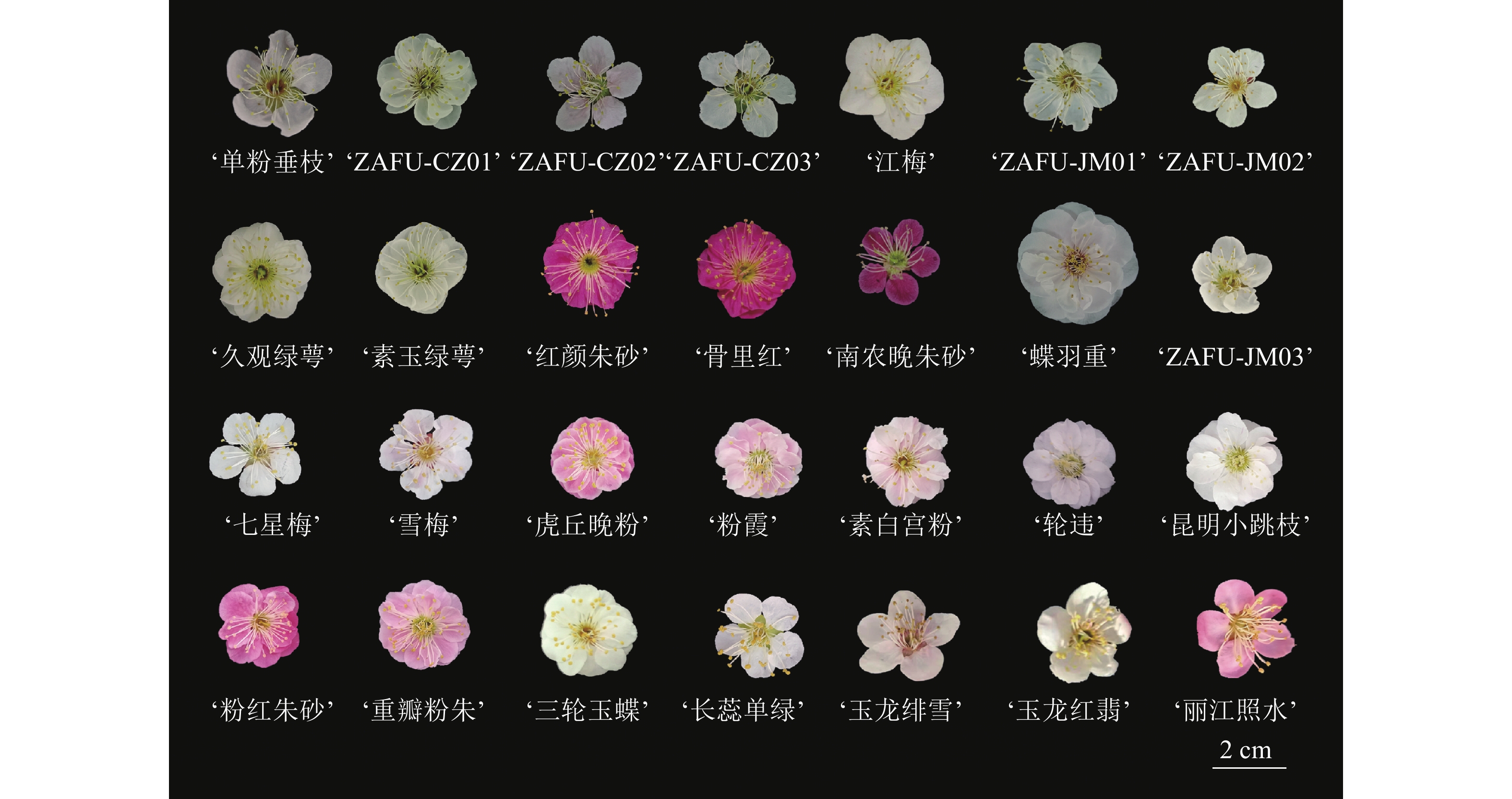


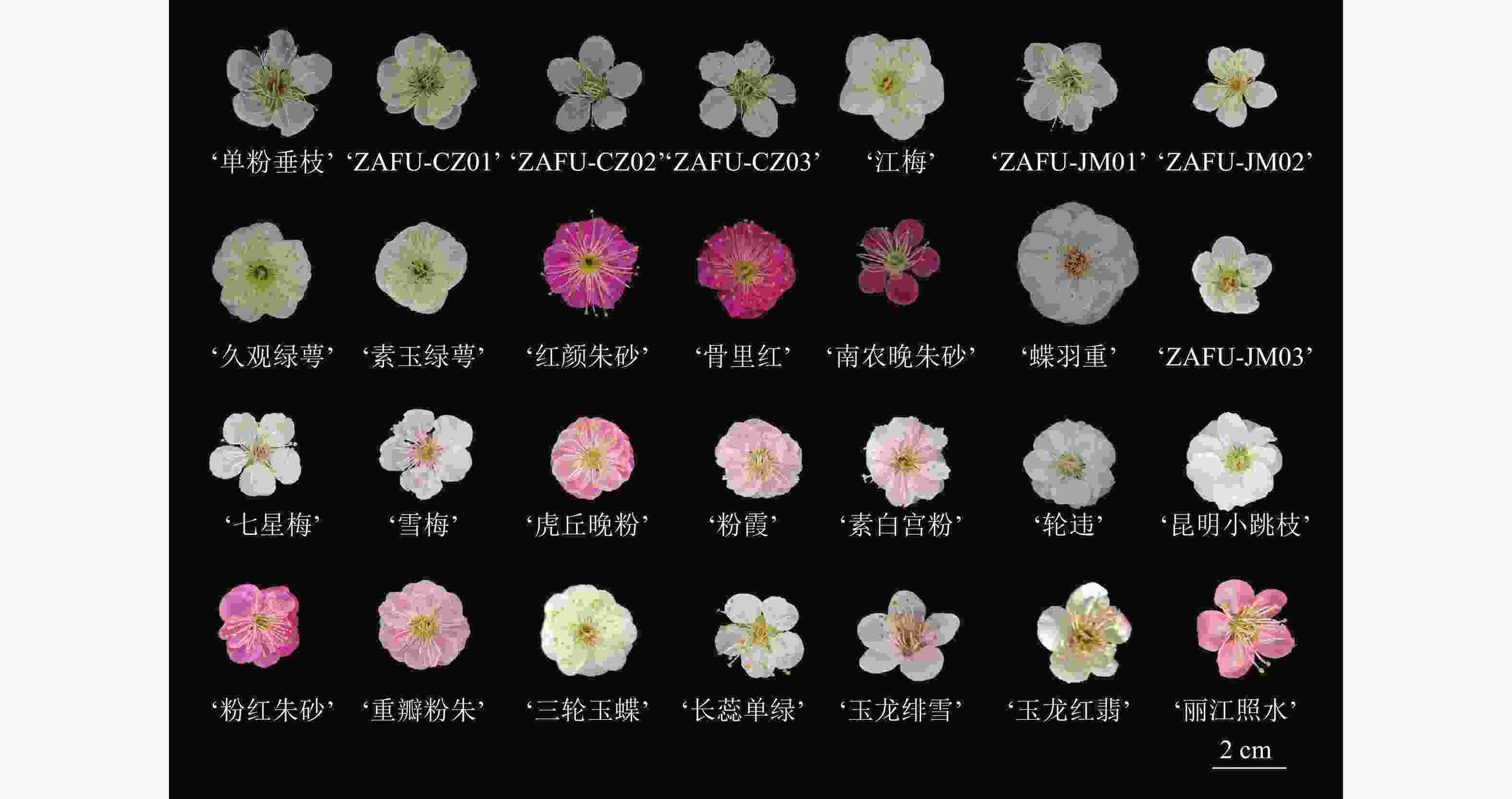



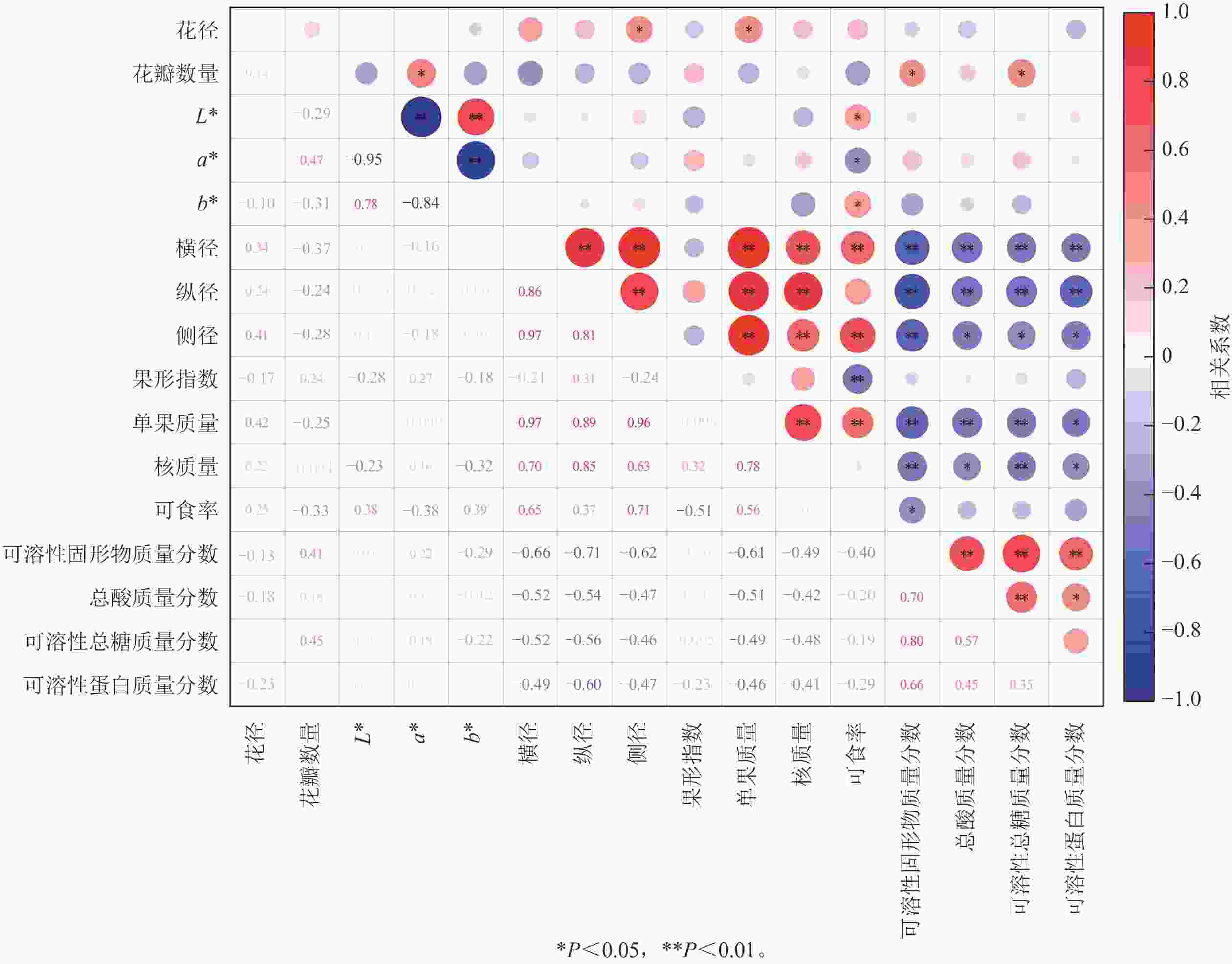
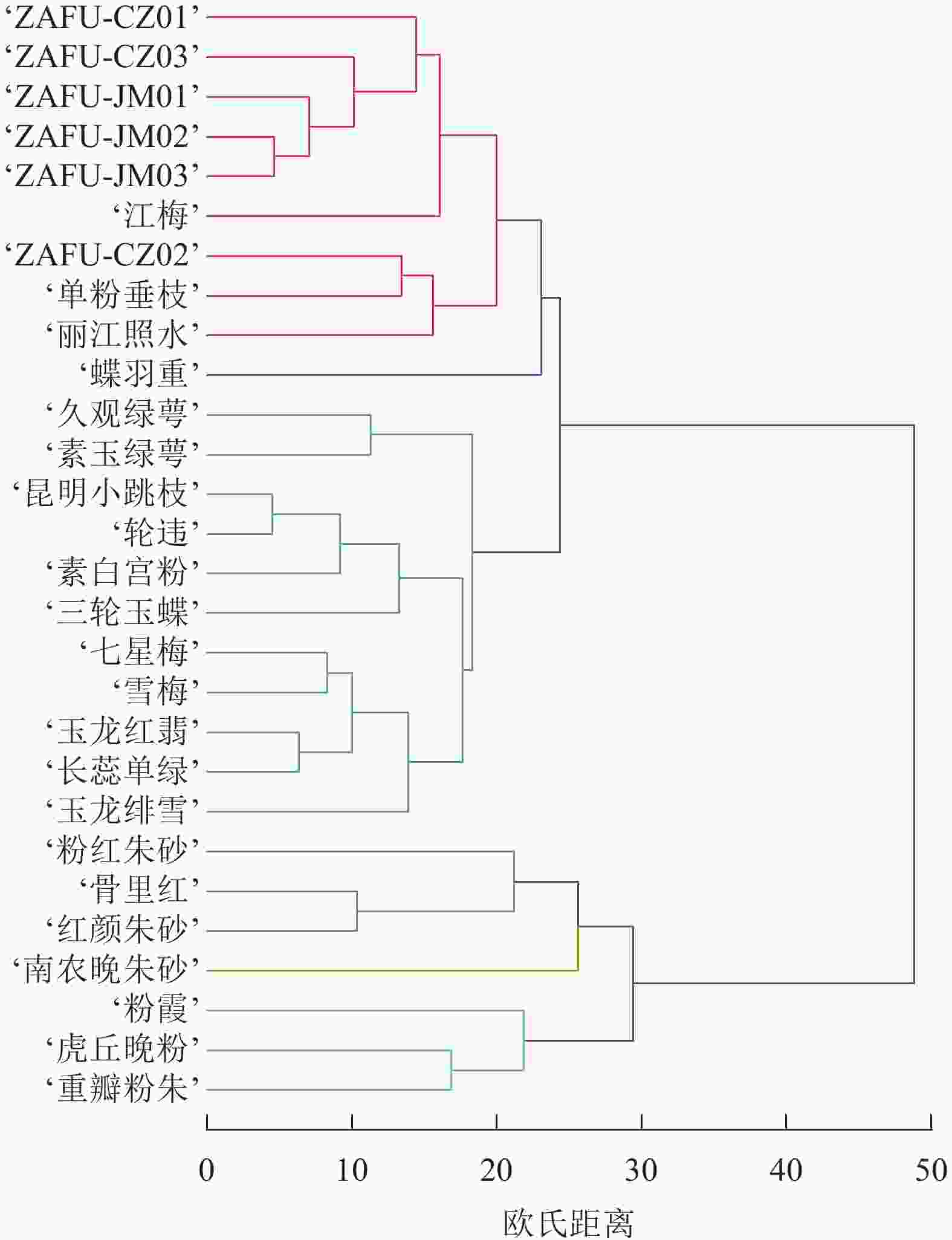
 DownLoad:
DownLoad:
